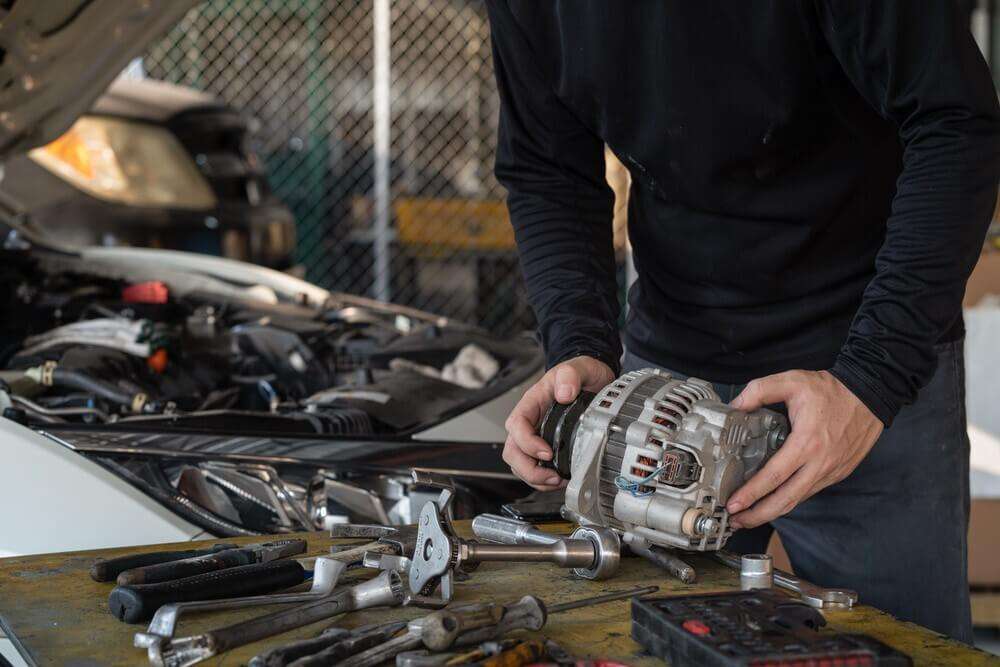Does your car fail to start in the morning? Does its battery drain faster when you leave it parked? These could be symptoms of a failing alternator.
While the alternator may be a complicated piece of machinery, testing your alternator is a relatively easy task. If you want to know how to test alternator with screwdriver, you’ve come to the right place!
It’s a fairly simple process that can be completed within a couple of minutes. To complete this method successfully, all you need is a screwdriver that’s free of rust and place it on the alternator’s bolts.
The complete step-by-step guide is discussed below in the article, which will help you test whether or not your alternator is working correctly.
Jump to
What is an Alternator in a Vehicle?
The alternator is an important part of your vehicle’s electrical system as it helps charge the car battery. It creates electricity to charge the car battery and power all of your accessories in the vehicle. The alternator needs to be tested periodically because it is.
It’s basically a rotary device that converts mechanical energy to electrical energy, used to produce AC (Alternating Current) electricity. An alternator is used to power the electrical systems of automobiles, boats, planes, motorhomes, trucks, and trains.
It connects the car’s battery and engine and creates electric power for your vehicle. It also increases the alternator’s voltage output and gives you a continuous current for your radio, lights, and other accessories.
You may notice a clicking sound when you turn on your lights, this is your alternator hard at work. It is actually the same mechanism of creating electricity that happens in a dynamo or generator, just smaller.
How Does an Alternator Work?
The alternator has a pulley that spins as your turn on the engine. It further spins the alternator rotor, which is made of an iron core and wire coil. It creates electricity (field current) that flows through the wire coil and creates a magnetic field, which results in an alternating current.
It’s important to note that the car alternator needs a voltage regulator to produce the voltage required to charge your car’s battery. The regulator helps the alternator to generate and transfer constant voltage to the battery terminals.
The alternating current that the magnetic field creates is converted to a direct current with the help of diode bridges or rectifiers, and this DC voltage is used to charge the battery.
The whole system, including the alternator and regulator, makes up an induction motor. The greater the current it produces for the coil wire the more powerful the magnetic field will be. Thus, the alternator will produce a higher DC voltage to charge the battery.
Keep in mind that the regulator, attached to the vehicle’s battery, also ensures that the alternator sends out the right amount of voltage required to charge the battery. That’s because too high or low voltage levels can damage the battery, along with other electrical parts of the vehicle.
If the battery voltage drops, the regulator generates a more powerful field current for the wire coil to produce a stronger magnetic field. As a result, the alternator generates more power.
Whereas, if the battery voltage increases, the regulator lets less current to the rotor to lower the alternator’s voltage output.
What Happens If the Alternator Fails to Work?
The alternator is crucial for your vehicle. If it is not working, it could mean a very expensive repair bill. If the alternator fails, your battery loses its charge and eventually dies. Your vehicle will no longer start and you will be stranded on the side of the road.
This is why it is essential to test your alternator regularly. Therefore, it’s important to know how to test your alternator and save yourself the need for an expensive repair job.
Testing the alternator with a screwdriver is a simple process that you can easily do at home. You don’t have to take your vehicle to the mechanics or auto repair shop just for this test.
The process involves a few steps, but before you start make sure that the car is off and parked in a safe spot. After that, you can follow the steps listed below to complete the process.
Step 1: Ensure Your Safety
The first step is to ensure your personal safety because you’ll need to work with electricity and a screwdriver. Therefore, make sure that you wear a pair of insulating gloves. A little care won’t cost you anything but it can save you from a whole lot of trouble.
Step 2: Insert Key into Ignition
The next step is to insert your car key into the ignition switch. Don’t start the car up. Just insert it into the slot and leave it there.
Step 3: Open Your Car Hood
In order to test the alternator with a screwdriver, you have to open your hood. Find the latch on the underside of the hood and pull it up. This is how you can access your alternator for testing.
Step 4: Find the Alternator
The alternator is a large coil-shaped device with a belt attached to it that goes over other engine parts. Depending on your vehicle, you may see additional belts, pulleys, or gears near the alternator as well.
The main part of this device is hooked up to a battery through a cable. Ask someone to help you out or get yourself a manual if you can’t find it. It’s usually placed near the engine.
Step 5: Place the Screwdriver Near the Alternator
Once you have located the alternator, use your screwdriver to test it. But before grabbing the screwdriver, turn on the ignition. The car won’t start but the dashboard lights will turn on. Make sure that you don’t start the engine.
Now hold the screwdriver close to the alternator and touch the tip of your screwdriver’s blade to the alternator pulley bolt. If you feel a magnetic field, attracting the screwdriver, your alternator is working fine.
How to Test the Alternator with a Multimeter
The most common way to test whether your alternating is working properly or not is to use a multimeter. And here’s how you can complete this process.
- Wear insulating gloves to ensure your safety.
- Change the multimeter settings and set it to measure volts.
- Now attach the black lead of the multimeter to the negative battery terminal and connect the red one to the positive terminal.
If the multimeter shows 12-volt reading (or more) your alternator is in good condition. But if you see a lower than a 12-volt number, you need to replace the alternator with the new one.
Regardless of the method you choose, make sure that you never disconnect the negative battery cable to test the alternator if you have a modern vehicle. While this method works to test the alternator of old vehicles that don’t come with onboard computers, it’s not a safe method for new cars.
That’s because disconnecting the negative battery wire to test the alternator in modern vehicles with onboard computers can wreak havoc. It can fry every electrical device that your car has, costing you a whole lot of money.
Common Signs of Alternator Malfunctioning

If you have ever run out of battery in your car, you know how important this component is. The alternator is responsible for charging the battery. However, if it fails to do so, you could face some costly consequences.
If you’re not sure whether your alternator is working, here are six common signs an alternator may be malfunctioning.
- The headlights, dashboard lights, and other electrical systems start flickering or dimming.
- The battery isn’t holding the charge and needs recharging more often than usual.
- The engine often “bogs down” as if it’s not getting enough power.
- The air conditioner malfunctions or blows at much less than maximum.
- The vehicle sometimes stalls or makes unusual noises such as a clicking, whirring, or humming sound when the engine is running.
- The battery light turns and stays on when you turn on the ignition.
If you’re experiencing one or more of these signs, it’s time to get a professional opinion before the alternator completely fails.
FAQ’s
1. How do I test to see if my alternator is bad?
Get your engine running smoothly with a simple test to check the health of its alternator. Start by lifting up the hood and turning on your car – then disconnect the negative cable from its battery. If it stalls or powers down, that’s an indication that something is amiss! It could be due to a faulty alternator not generating enough electricity for continued operation without outside help.
2. Can you test alternator by removing battery cable?
Don’t be tempted to test an alternator by disconnecting the negative battery cable – it may actually keep your engine running, but this is not a safe or effective means of testing one. Before cars used computers for their control systems, you could get away with doing so without causing any harm – however those days have passed.
3. Can alternator drain battery while car is off?
If an alternator diode is faulty, it can cause your car battery to become drained even when the vehicle isn’t in use. The result? A dead battery that won’t let you start up – so pay close attention to any possible issues with this part.
4. Can you test an alternator without removing it?
To get a good assessment of the alternator’s condition, fire up your car and give its electrical system some work – switch on those heavy loads like blower motors or headlights. Then look for voltage at the battery terminals to help you determine if everything is running smoothly.
Final Words how to test alternator with screwdriver
We hope this article has helped you understand the correct way to test the alternator of your vehicle. The easiest and most accurate way is to use a multimeter. But if you don’t have this device, you can use a screwdriver for the same purpose.
Using this simple process will give you a pretty good idea of whether or not your alternator is working properly. If there is any question about the alternator or you want to share your experience with us then please comment below.
If you like this article, then please don’t forget to share. Good Luck! Cheers!
Also Read: How To Break Into A Ford F150 Keypad?

My name is Tom Harris, founder of this blog. I’m a mechanical engineer with 20 years of experience in the automotive industry. I’m here to help you with your vehicle’s problems, easy fixes and share my insights and experience so that you can enjoy your rides more.

